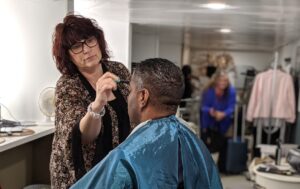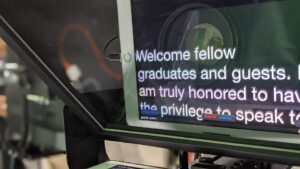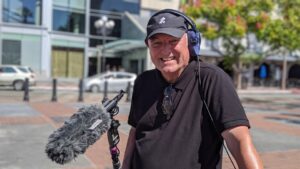Video Production “Extras” You Should Consider
When planning a video production day, there are the basics – camera, lighting, and audio. Beyond that, there are some “extras” that really add another layer of quality to any project. Back in part one of this series, we used the analogy of buying a car and mentioned the difference between buying just a base model versus buying one with some extras added in. For part three of our series, we’re going to cover some of those “extras” for your video project more in depth, and why/when you should really consider having them on set.
One Chance for First Impression
![]()

Let’s start with one extra that is something we recommend on a regular basis – a makeup artist. Having your onscreen talent look the very best they can is critical to making a great first impression. While lighting can make people to look good, having a makeup artist on set really helps in making people look and feel their best. They are usually the last person the on-screen talent sees before going to the set – their skills and attitude can help the talent feel comfortable and more confident. Also, many are educated in lighting, cameras and editing so that they are able to know which hues of color will work best on the talents skin tone and undertone. They arrive prepared on all sets with a full makeup kit for all skin tones. Something else they provide is hair touchups, small nail kits, tattoo cover and body makeup if necessary. And they keep a watchful eye during filming for anything that needs to be touched up.
Now, if your project is a small, internal-only video that’s being seen by a small audience, maybe a makeup artist isn’t needed. But in most other cases, trust us when we say, you’ll be so glad you had one on set. The overall value they provide reaches far beyond the added budget.
Reading versus Memorizing

Teleprompters aren’t just for newscasters. They can make a huge difference when filming someone talking to camera. If your project requires someone to read or speak from a script, having a teleprompter on set will be something your talent will thank you for. We’ve had many pre-production meetings where we’ve been assured that the on-camera talent has “done this talk a thousand times – they don’t need a teleprompter”, only to find out once that person is in front of the camera and lights, it becomes much more challenging.
For most corporate videos, the person on camera won’t be a trained actor, and you can’t always expect them to memorize a 2-3 page script and deliver it with emotion. When the talent doesn’t feel comfortable being on camera, they often start struggling with the script they tried to memorize, and their performance suffers as they become more and more self-conscious. Having a teleprompter for them to read from provides a level of comfort as the talent can just focus on their delivery. It also allows for easy tweaking of the script as the prompter operator can quickly make any changes and updates to the script during the shoot.
From a time and budget perspective, having a prompter on set can sometimes make a full day shoot into a half day. Reading from a prompter, talent often gets through the script more quickly, which ultimately saves on budget. And when you have those hard to schedule upper-level execs on camera, anything that helps them film their parts quicker is a plus.
Audio is Half the Experience

Director George Lucas said, “Sound is 50 percent of the movie going experience”. Great sound is always as important as beautiful video. When the filming starts, the camera operator has a lot on this plate – they make sure the person on camera is in focus, exposure is right, framing is correct, there’s nothing moving or visible in the background that could be distracting or shouldn’t be there, and in some cases they need to make sure the audio levels are good and everything sounds clean. That’s a lot to do all at once. Which is why having a dedicated audio tech on set can be a huge help.
For some basic “interview with b-roll” video shoots, the camera operator can usually handle the audio needs by setting up a shotgun microphone on a boom pole and/or using a lavalier (lapel) microphone on the interviewee. But in most other situations, having a dedicated person handling all the audio requirements is extremely beneficial. Some of these situations would be:
– Complex projects where the camera crew focus needs to be solely on lighting, framing, and focus.
– Multiple people on camera at the same time
– Filming outside or at a location that can be noisy
– If talent is moving around or needs to have the microphones hidden in their clothing
– Days when you’re filming in several different locations
A dedicated audio person is entirely focused on providing great sound, and they’ll bring the proper tools for each project. They have numerous specialized mics for just about every situation, so no matter where or on what clothing you need to hide a mic, it will always sound good. One of the audio techs we hire has what he calls his “magic box”, and when used it can reduce the amount of background noise while recording. We’ve used it in loud laboratories when we couldn’t turn off working machines, and it removed much of that background noise so we could clearly hear our on-camera talent.
We always want to make sure that we capture the best quality audio possible for your video production. During any pre-production meeting, it’s good to have a conversation about if an audio person is right for your project. At 100 Acre Films, we will always advise you what we think would be best for your project, and list the reasons why we feel it’s needed or not. We always come at things from a production quality viewpoint first, and then from a budgetary one.
The Tracking Shot
You’ve seen these shots MANY times before when watching movies, shows, commercials, sports, or even corporate videos – the camera moving around, following a subject with smooth motion. There are a number of ways to get that shot using a few different tools. But a common way is using either a gimbal or a Steadicam. What’s the difference? A gimbal is usually a smaller rig, handheld, with a smaller camera on it. A Steadicam (or similar device – there are many different brands) is a larger rig that is actual worn by an operator. Both can achieve amazing looking tracking shots that add another level of production value to your project. Need a shot of a person walking through a facility to get a sense of the space, point of view shots, moving b-roll shots, or just walking down a hallway – one of these options is your best choice.
Talking about your project in pre-production, we can discuss the shots you’re looking for and determine if one of these tools would be appropriate. As they are very specialized tools, they do require specialized crew trained to use them in order to achieve the amazing footage they provide. They also can require extra setup time and coordination as well as extra crew members such as an assistant camera person and/or focus puller. But the end result is a great looking shot that will surely elevate your production. The energy and style it adds to your project is instantly visible.
We Have You Covered
We hope you now have a better understanding about what each of these “extras” can bring to your production, and why having them in some cases is better than not having them. Each adds a higher level of quality and polish to your final video. As mentioned, we understand that they add to the overall budget, so that’s why 100 Acre Films will always work with you to help determine which of these things would best suit your project. Our goal is to always make sure your video production project looks and sounds the best it can. Telling your story the most impactful way possible is what we strive for.
If you have any questions after reading this, or have a project you’d like to discuss, please use the contact form to reach us. Or you can call us at 619-255-9410.
Want More Information?
Additional Posts
Contact
We’d love to hear from you! For inquiries regarding projects, employment, or just to say hi, send us a message here.